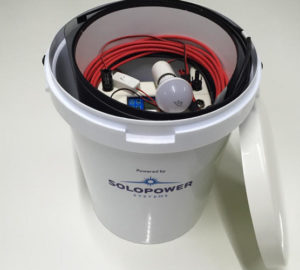Source: fastcoexist.com
Published: September 22, 2016

With no instructions or expertise needed, the kit is ideal for off-grid homes in the developing world.
Installing solar panels usually takes a couple of days and trained workers. But a new solar kit, designed for off-grid areas in rural Africa or Asia, can be set up in minutes with no instructions or tools.
“Each cable can only attach in one way, so just simply by trial and error at the beginning, it would set up correctly,” says Robert Campbell, CEO of SoloPower Systems. “So literally instructions are not even needed for the product. The concept was to make it as simple as possible, and to make it secure it would always be attached in the right sequence, so you’d always have the correct installation.”
The kit, with a flexible, durable solar panel, a battery, connectors, lighting, and chargers, fits inside a plastic bucket, so it can easily be carried back to someone’s home; the whole kit weighs around 20 pounds.
Click here to watch “Bucket 1080”: https://youtu.be/7K0T9Yafcz0
“When we compare it to other technologies, what stands out is the extremely lightweight nature of our technology compared to other more traditional technologies,” Campbell says. “And the fact that we can roll it up, and transport it.”
Because the solar panel goes up and down so quickly, the company expects that users will bring it inside at night. Solar panels attached to roofs are often stolen or damaged.
Of course, a single small panel can’t provide as much power as a fully covered roof of panels in the U.S. But the battery can fully charge in three hours, providing enough power to charge five smartphones, run LED lights for 10 hours, or a TV for three hours.
SoloPower plans to work with nonprofits and governments to fund the kit, called SoloBucket, and will also offer micro-financing, so families can pay for the panel the same way that they’d pay for a mobile phone.
In South Africa, the company has partnered with the government to bring the kits to 10,000 homes in rural villages. While some countries are moving quickly to build bigger electric grids–India, for example, wants to bring electricity to every village in the country in two years–those plans don’t include every home. More than a billion people still don’t have even the basic electricity to power a lightbulb for studying or working at night.
